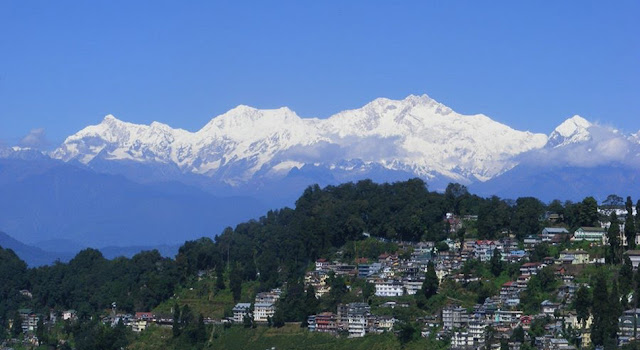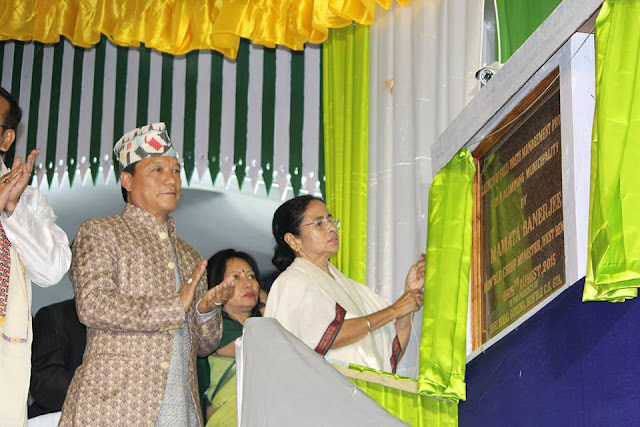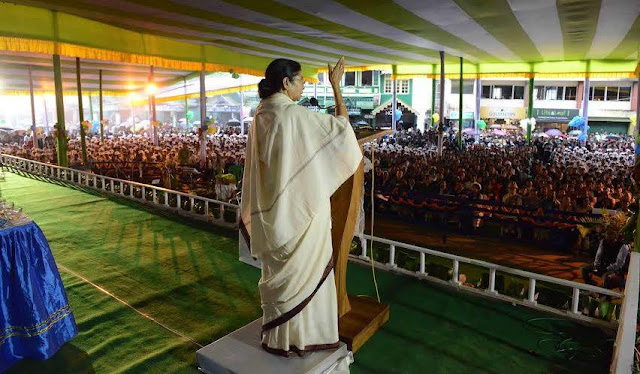Writes: Prajwal Parajuly
At Tiger Hill, Darjeeling’s famous viewing point, stands an observation tower. As early as 5am, the bottom two floors of the tower are already crammed with standing tourists. We are on our tiptoes—there’s no room. The top deck isn’t crowded. Tourists there sit on sofas that were once plush and sip tea while men stand guard at the door. These men forbid us from entering.
“No tickets,” they say in English. “Sold out.”
We say we’ll pay extra. They say all the seats are taken.
We say we’ll stand. They say that would be obstructive.
One of us speaks in Hindi. It doesn’t work.
One of us tries broken Bengali. They glare at us.
I make a final request in Nepali. They let us in.
“Aye, we thought you were Bengalis,” the burly bouncer at the door says. “You should have told us right away, and we would have let you in.”
“What if we were Bengalis?” I ask, self-righteous now that I’ve already been the beneficiary of this one-sided ethnic rivalry.
“Then, we would maybe only allow you in if you paid us.” The bouncer cackles. His friends hoot.
“That’s discrimination,” I say.
“For good reason,” the bouncer replies.
Inside, the windows are giant, the sofas comfortable enough to snooze on when the mountain—or the sun—decides to delay appearance, and if you fancy closer Kanchenjunga views, you can perch yourself on stools right by the windows. Back in the day, this viewing deck might have been cosy, even luxurious. But it’s in disrepair now. Paint is chipping off. Walls are cracked. The rugs covering some sofas are threadbare. The bathroom needs water.
Around us, mostly Western tourists, bleary eyed yet hopeful, tinker with their cameras and wait.
“It will rise today,” the burly bouncer promises. “It will.”
“Did you see the sun yesterday?” I ask. Early November is usually a great time to visit Darjeeling, but it had been a gloomy few days.
“Yes, we did,” the bouncer replies. “And the day before.”
We amuse the bouncer and his friends. We are from Sikkim, right next door, and yet we’ve dragged ourselves from bed in the cold, even before the crack of dawn, to see what we’ve been taking for granted all our lives.
“You people are behaving like exact tourists,” the bouncer jokes. “One of you must even have a monkey cap.”
We deign to laugh. He’s being snide about balaclavas, favoured by Bengali tourists, who descend on Darjeeling and neighbouring areas in droves. Singara tourists, the locals call them. Travellers on a budget who’ll haggle you down to the last rupee. Their money-spending capacity notwithstanding, the sheer number of these tourists have kept tourism alive in these hills for years.
I ask Prakash, who says he’s not a bouncer but a part-time guide, why the place isn’t well maintained.
“What do you expect, mams (brother)?” he says, slipping into lingo that’s archetypically Darjeeling. “This is Darjeeling. Do you think Bengal cares? Why shouldn’t we hate Bengalis? They’ve robbed us of all our tourism and tea revenue, and we are left with nothing. No money. No Gorkhaland. Nothing.”
“But hasn’t there been some development in the last few years?” I ask.
And that’s invitation enough for Prakash to segue into a 45-minute diatribe on everything that’s wrong with Darjeeling. As the clouds part to make way for the sun to reticently emerge and weave its magic in the sky, Prakash asks me if a place like Tiger Hill would be as poorly maintained in Sikkim. I say it wouldn’t. When shutter-happy tourists scuttle from one end of the room to another for views of the mountain changing hue, Prakash fills me in on the ill- treatment meted out to Darjeeling by West Bengal
Every trip to Darjeeling I’ve taken as an adult leaves me sadder than the last. Nature continues being bountiful. Man continues being destructive.
The click-clacking of horses on the Chowrasta, Darjeeling’s pedestrianized square, is enough to transport me to happier, carefree days. We often spent weekends here when I was a child. Gangtok, my hometown, was a long way from becoming as shiny and Swiss as it is now. Darjeeling was only a 4-hour drive away. A trip wouldn’t be complete without horses to ride on at the square, cakes to feast on at Glenary’s and schools to visit, where, it was understood we’d board for a year or two when we grew older.
Of course, the town—and all of North Bengal—was in the midst of gargantuan problems. The Gorkhaland revolution—that impassioned movement that everyone here hoped would result in the creation of the Nepali-speaking-majority state of Gorkhaland, a separate entity from West Bengal—had reached its crescendo in 1986-87. The Nepali-speaking people of West Bengal, the majority of whom live in the Darjeeling hills, demanded statehood on linguistic and ethnic grounds. It was an often-violent movement, and clashes between the agitators and the CRPF personnel were frequent. Curfews, months-long strikes and killings were normal.
Yet my family was undeterred. The minute we’d hear of things returning to normalcy, we’d pack our bags for a weekend away. We made frequent trips because Gangtok didn’t have a decent bookstore in the late 1980s. Darjeeling’s Oxford Bookstore, bang in the middle of the Chowrasta, was where I purchased my first Puss In Boots book. We went because all of us cousins had unending hankerings for the chocolate éclairs at Glenary’s. We went because the Windamere Hotel, where, we were told, the last king of Sikkim courted the American Hope Cooke, charmed us. We went because we loved to see tea leaves being crushed and curled at the many tea gardens. We went because the Kanchenjunga was visible from far more points in Darjeeling than it was from Gangtok. We went, above all, because we couldn’t get enough of Darjeeling’s toy train, songs about which—Darjeeling’s little train/is ready to start/Listen to the whistle of the guard, brother/the train’s ready to chug along—had been our lullaby since the day we were born.
It was to capture the magic of this era, to relive a bit of our childhood, that we took our most recent trip to Darjeeling. Well-meaning people had warned us. Everyone said we’d be disappointed. We reasoned that if we loved Darjeeling at the peak of the agitation, it couldn’t be so bad now. We were prepared for the worst. We were prepared to return sadder.
If reports are to be believed, all Indian hill stations are going downhill.
No piece on Kashmir spares an allusion to the gross commercialization of Srinagar. Rampant construction is proving to be Mussoorie’s undoing. Ooty has its trash problem. The monkeys in Shimla are a menace. The roads to Gangtok are horrendous. Café Coffee Days and Subways make all hill stations look like clones. Darjeeling’s biggest problem is that it hasn’t quite recovered from the agitation of the 1980s, which spawned several smaller movements, some of them as recent as two years ago. The movements—almost always accompanied by strikes, the closing down of schools and the blocking of the national highway—have done more bad than good. Add to this a state government with whom the local government is perpetually at loggerheads, and the result is massive infrastructure deficit, manifestations of which we could see at the Tiger Hill viewpoint and everywhere else in Darjeeling. That the district is a tiny, tiny part of a big state doesn’t help. The affluence of Sikkim, Darjeeling’s closest neighbour, into which the Central government funnels huge amounts of money, pinches hard.
Phurba, our driver for much of the trip, claims to have participated in the 1980s’ agitation. He says he was shot but doesn’t show us bullet marks when we ask him. Like almost everyone we speak to, he has had it with the West Bengal government. I ask him what his children do.
“Call centres in Delhi,” he says as he manoeuvres a serpentine bend toward the Padmaja Naidu Himalayan Zoological Park, where we want to see pandas. “The older one stuck around for four years after graduating from college. But there are no jobs here.”
Darjeeling’s decline is evident not just in the trash-strewn streets, the lack of water and buildings standing cheek-by-jowl but also in the rapidly dwindling youth population. Everyone complains about the absence of opportunities.
“Will they ever come back?” I ask as we whizz by lush green hills of tea. We’re barely 3km from the square, the heart of Darjeeling’s concrete jungle, and here’s 400-plus acres of pure greenery in the form of the Happy Valley Tea Estate. As though to compound the estate’s picture-perfect quality, women plucking tea leaves and depositing them into their doko baskets soon come into view.
“Only when Gorkhaland happens.”
There’s the G-word again. People may be disillusioned with their leaders. They may have little hope in their government. They may encourage their children to move to greener pastures. But everyone believes—fervently believes—that Gorkhaland will happen.
I express pessimism about Gorkhaland. Phurba isn’t too keen to discuss further.
“Don’t forget to see the Royal Bengal Tiger,” he says. “And make sure you see the (Himalayan Mountaineering) Institute Museum.”
We are let off.
The agitation of the 1980s led to the creation of a semi-autonomous body called the Darjeeling Gorkha Hill Council. Since then, the demand for statehood has been the background score to almost all movements. Semi-autonomy has been the greatest extent to which the state and Central governments have budged. Yet another movement that started in 2007 under a different political party led to, five long years later, the abolition of the Darjeeling Gorkha Hill Council and the creation of the Gorkhaland Territorial Administration, supposedly slightly more autonomous than the Darjeeling Gorkha Hill Council. To the masses, there’s little difference.
We are in a meat eater’s paradise called Keventer’s. On the plate in front of me are strings of bacon, ham, salami and sausage. To my opposite are two vegetarians. A hand-written sign on a poster across the street arrests my attention.
“WE BELONGS TO SAME IDENTIFICATION AND COMMUNITY,” the poster reads. “LET WE DO UNIFICATION SIKKIM.”
I do a double take. I ask our waiter what he thinks of the proposed merger with Sikkim.
He’s a Bengali from Jalpaiguri. He doesn’t care.
“Would you like to be merged with Sikkim?” I ask a different waiter.
“I’d like Gorkhaland,” he says. He has a hopeful look.
“And if that’s not an option?”
“The second best thing would be to merge with Sikkim. We were once one.”
That’s true. Darjeeling was a part of the kingdom of Sikkim until 1780, when Sikkim surrendered Darjeeling to Nepal. When the British defeated the Nepalese in the Anglo–Nepalese War of 1814–1816, Nepal was forced to cede Darjeeling to the British East India Company. In 1817, the British returned Darjeeling to the king of Sikkim. So, yes, the Sikkim-Darjeeling merger talk has a historical backbone.
“Like Sikkim would be willing to share her fortunes with you,” I say.
“They have to help us out,” the waiter says. “We are basically the same people.”
“But think of all the trouble you’ve given us—we miss so many flights because you close off the national highway. There’s no other way for us to get to the airport.”
“But we have more in common with people in Sikkim than we do with Bengalis. Our festivals are the same. We speak the same language. We have the same culture. It only makes sense.”
“And all the schools you close off knowing that our children study here. How do you expect support from Sikkim when you’ve made so much trouble?”
The waiter doesn’t know what to say. I am aware I’ve put him in a spot.
“I know you personally didn’t cause me to miss my flight,” I say. I apologize.
We pay the bill and head to Glenary’s. The éclairs are smaller than we remember them. We can’t say if the taste has changed too. Someone at The Buzz, the basement bar at Glenary’s, shows me a picture when I bring up the issue of the Darjeeling-Sikkim merger.
“DARJEELING BELONGS TO SIKKIM. SO DARJEELING UN …” The rest of the poster has been ripped off.
The Chowrasta, Darjeeling’s square, still smells like horse manure. I enjoy the smell. Of all the mall roads in India, this is my favourite. Gangtok’s square is too sanitized; almost all the old buildings have been torn down. The Chowrasta is dirty in comparison. Some of the stores are housed in buildings that look like they are about to collapse. One of these ancient shops is the Oxford Book & Stationery, that store of my childhood. I still have that tattered copy of Puss In Boots in my New York apartment.
I’ve promised Maya, the owner, that I’ll sign copies of my books when I am in town. As I make my way in, I marvel at the presence of a massive bookstore—so unapologetic about its size—in this location, the best possible site in Darjeeling. Oxford employs six full-time employees, one of whom, Maya says, has been with her family for more than 50 years, and another for 47. The store is spacious, conducive to browsing and well stocked. Maya says tourists this year have been few. If the number of people in the store is any indication, she doesn’t need to worry about business. The store has no problem with footfalls, I point out.
“Not everyone who’s here buys a book,” she says.
“That’s true.”
“But that’s fine. That’s how book stores should be.”
“Haven’t you been tempted to abandon the book store and open something else, do something more lucrative?” I ask. “I mean, this is prime real estate.”
“This place will always be a book store,” Maya says, with finality.
I am filled with affection for this lovely space. It reminds me of all the great book stores in my life—places that made me a writer and are now supporting me as a writer.
Outside, the clouds have vanished. The mountain wows us. The weather hadn’t been very cooperative on the day we went to Tiger Hill. Today is different. The sky is a brilliant blue. Here’s the Kanchenjunga—so close, so confident, so generous—standing sentinel over the hills. We give up taking pictures. We don’t want to trivialize the mountain, the moment.
Soon, the mountain recedes. A sarangi player restrings his instrument while his partner prepares to sing something folksy. A pony neighs and defecates on someone’s shoe. Tourists are alarmed. Locals laugh. A nervous young girl circumnavigates the square on horseback. From a makeshift stage a politician’s rants echo. He says something about Gorkhaland and unfulfilled promises. The crowd breaks into raucous applause.
Source : Live Mint










+Avinash+Gurung+at+the+Gorkha+Rangamanch+Bhavan+in+Darjeeling+on+Saturday;+Bimal+and+Asha+Gurung+in+the+audience.+Pictures+by+Suman+Tamang.jpg)


